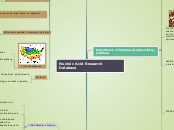por MUHAMMAD HAFIZUDDIN BIN YUSOF 10 anos atrás
462
Nucleic Acid Research Database

por MUHAMMAD HAFIZUDDIN BIN YUSOF 10 anos atrás
462

Mais informações
Subtopic
The provided metadatabase can serve as reference and resource for subsequent cellulase research like screening the resource(short gun sequence) for cellulase homolog families.
Novel cellulase discovery can be conducted via metagenomic approach that extracts enormous biological information from the unculturable one which is inaccessible otherwise
A four level project classification was utilized for metadata integration improvement and accommodate different sequencing projects association
Sequencing projects are catalogued and monitored whilst their metadata is stored, manually-curated and disseminated with quality control by the GOLD data management
Comparative genome analysis of cellulase gene families can reveal differences of phylogenetic tree among species; gene structure and location for gene homology study; transcript level for gene expression study and in general, study evolution of cellulase genes and its metabolism pathway
Various cellulase are present and expressed as participate in plant life stages like ripening and abscission. Therefore, plant genome contains rich source of novel cellulases sequence to be study
Quality (high coverage) genomic information of the 37 plant species includes gene families, protein domains, phylogenetic tree, structural and functional annotation
Comprehensive and intuitive web interface of comparative plant genomic data for facilitating data visualization, interpretation and analysis
Due to its capacity to produce large amounts of cellulases in the biofuel production, Trichoderma reesei is increasingly being investigated for second-generation biofuel production from lignocellulosic biomass. To increase the production of cellulose, it can be done by RNA post-transcriptional regulation. By using DoRiNA 2.0, it easy to find information about RNA post-transcription regulation.
DoRiNA 2.0 is a latest version database of doRiNA database. DoRina database was upgrading to DoRina 2.0 in order to update new information of RNA interactions in post-transcriptional regulation and improve the usability of the website.
Functional assays may involve the direct screening of gut extracts or the expression-based screening of genes identified by sequence mining.
Sequence mining is a bioinformatics approach that involves the screening of genomic, transcriptomic, or proteomic data for cellulase signatures, based on sequence and structural homology.
The 5000 arthropod genomes initiative (i5k) has tasked itself with coordinating the sequencing of 5000 insect or related arthropod genomes. The resulting influx of data, mostly from small research groups or communities with little bioinformatics experience, will require visualization, dissemination and curation, preferably from a centralized platform.
The GenoBase that has information of E.coli K-12 can be use to produce celulllase by making the E.coli K-12 as a host.
Designed to facilitate classification of sequenced and yet to be sequenced chromosomal regions for efficient sequencing
Which contains key information about comprehensive experimental resources of E. coli K-12, their quality control and several omics data sets generated using these resources.
This database includes information related to ligand molecules on the enzyme structures in the PDB data, classified in terms of cofactors, substrates, products and intermediates, which are also necessary to elucidate the catalytic mechanisms.
Application
Celullase catalyze cellulolysis, specifically; the hydrolysis of the 1,4-beta-D-glycosidic linkages in cellulose, hemicellulose, lichenin, and cereal beta-D-glucans because of that EzCatDB are useful in this proses that can identified database of hydrolysis
Reaction that can be identified this database types such as hydrolysis, transfer, addition, elimination, isomerization, hydride transfer and electron transfer have been included in the reaction classification, RLCP